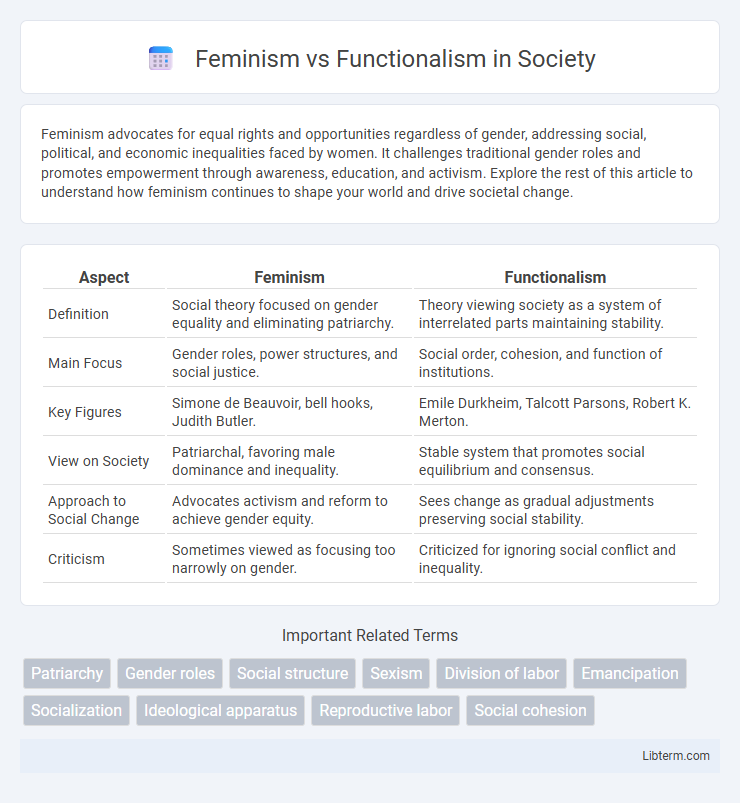Feminism advocates for equal rights and opportunities regardless of gender, addressing social, political, and economic inequalities faced by women. It challenges traditional gender roles and promotes empowerment through awareness, education, and activism. Explore the rest of this article to understand how feminism continues to shape your world and drive societal change.
Table of Comparison
| Aspect | Feminism | Functionalism |
|---|---|---|
| Definition | Social theory focused on gender equality and eliminating patriarchy. | Theory viewing society as a system of interrelated parts maintaining stability. |
| Main Focus | Gender roles, power structures, and social justice. | Social order, cohesion, and function of institutions. |
| Key Figures | Simone de Beauvoir, bell hooks, Judith Butler. | Emile Durkheim, Talcott Parsons, Robert K. Merton. |
| View on Society | Patriarchal, favoring male dominance and inequality. | Stable system that promotes social equilibrium and consensus. |
| Approach to Social Change | Advocates activism and reform to achieve gender equity. | Sees change as gradual adjustments preserving social stability. |
| Criticism | Sometimes viewed as focusing too narrowly on gender. | Criticized for ignoring social conflict and inequality. |
Introduction to Feminism and Functionalism
Feminism advocates for gender equality and challenges systemic patriarchy, emphasizing women's rights and social justice through various theoretical perspectives. Functionalism, rooted in sociology, views society as a complex system with interconnected parts working together to maintain stability and social order. Understanding feminism involves examining power dynamics and gender roles, while functionalism focuses on the functions each social structure serves within the broader societal system.
Historical Development of Feminism
Feminism's historical development traces back to the late 19th and early 20th centuries with the suffrage movement advocating for women's right to vote, followed by second-wave feminism in the 1960s emphasizing gender equality in workplaces and reproductive rights. Unlike functionalism, which examines social institutions based on their roles in societal stability, feminism critiques these institutions as perpetuating gender inequalities and power imbalances. Key feminist theorists such as Simone de Beauvoir and bell hooks have deeply influenced social theory by challenging functionalist perspectives and highlighting systemic patriarchy.
Origins and Key Concepts of Functionalism
Functionalism, emerging in the early 20th century through sociologists like Emile Durkheim and Talcott Parsons, emphasizes societal stability, cohesion, and the interdependence of social institutions. Key concepts include social functions, where each element of society serves a purpose to maintain equilibrium and promote order. This perspective contrasts with feminism by focusing on harmony and the roles within social systems rather than power inequalities or gender-based oppression.
Core Principles of Feminist Theory
Feminist theory centers on challenging systemic gender inequalities and advocating for women's rights through social, political, and economic reforms. It emphasizes the importance of gender as a fundamental category of analysis, highlighting the power structures that sustain patriarchy and oppression. Feminism seeks to transform societal norms by addressing issues such as patriarchy, gender roles, and intersectionality.
Fundamental Assumptions of Functionalism
Functionalism assumes that society is a complex system whose parts work together to promote solidarity and stability, emphasizing social structures and their functions in maintaining order. It views social institutions as essential components that fulfill necessary roles for societal equilibrium, often prioritizing consensus over conflict. This perspective contrasts with feminism, which critiques the power dynamics and inequalities often overlooked by functionalist frameworks.
Gender Roles: Feminist vs Functionalist Perspectives
Feminist perspectives challenge traditional gender roles by highlighting how they perpetuate inequality and restrict individual freedom. Functionalist views argue that gender roles serve a purpose in maintaining social stability by assigning complementary roles to men and women, often emphasizing biological determinism. The feminist critique exposes the power imbalances embedded in these roles, while functionalism prioritizes social cohesion and order.
Power Structures and Social Inequality
Feminism critically examines power structures by highlighting how patriarchal systems perpetuate gender-based social inequality, emphasizing the need to dismantle male dominance in political, economic, and cultural institutions. Functionalism views power structures as necessary components of social stability, suggesting that different social roles contribute to the overall functioning of society, often downplaying systemic inequalities related to gender. While feminism challenges unequal power dynamics and strives for social justice, functionalism tends to justify existing hierarchies as functional for societal cohesion.
Critiques of Functionalism by Feminist Scholars
Feminist scholars criticize functionalism for its rigid focus on social stability and equilibrium, which often neglects gender inequalities and power imbalances embedded in social structures. Functionalism's tendency to justify the status quo overlooks how patriarchal systems perpetuate women's oppression and limits opportunities for social change. This critique highlights the need to analyze social roles and institutions through a lens that acknowledges systemic gender bias and advocates for transformative social justice.
Modern Applications and Relevance
Feminism emphasizes addressing gender inequalities and promoting social justice in modern institutions, influencing policies on workplace diversity, reproductive rights, and education reform. Functionalism analyzes society through the lens of stability and social roles, often applied in organizational management and social system design to maintain equilibrium. Contemporary debates highlight feminism's role in challenging systemic biases, while functionalism provides frameworks for understanding institutional functions and social cohesion.
Conclusion: Bridging Feminism and Functionalism
Bridging feminism and functionalism involves recognizing the complementary insights both perspectives offer on social structures and gender roles. Feminism emphasizes the need to address power imbalances and gender inequalities, while functionalism highlights the roles these structures play in maintaining societal stability. Integrating feminist critiques with functionalist analysis fosters a more nuanced understanding of social dynamics, promoting equity without disregarding social cohesion.
Feminism Infographic

 libterm.com
libterm.com